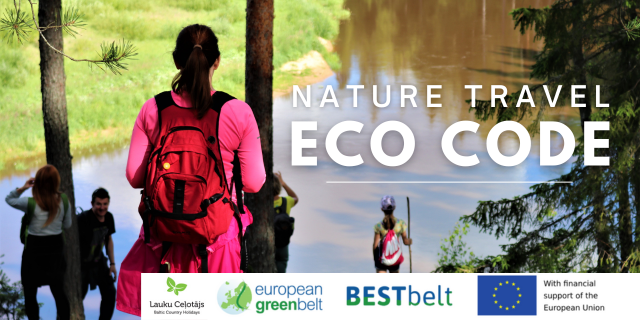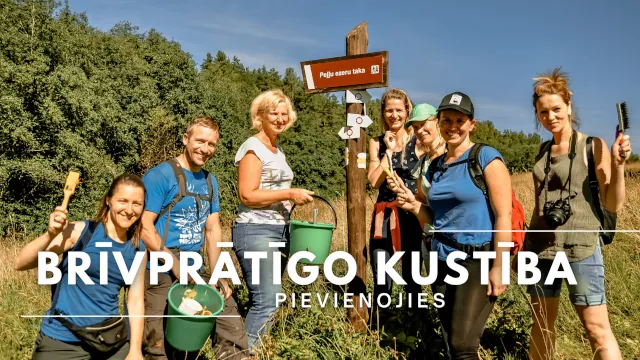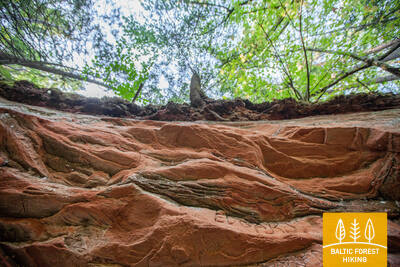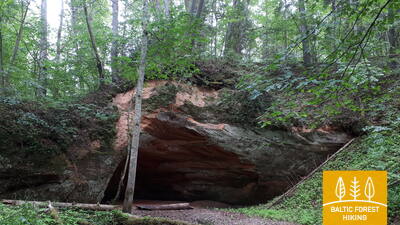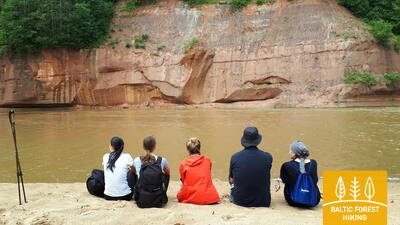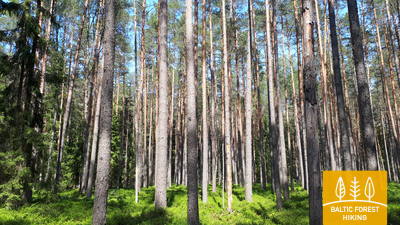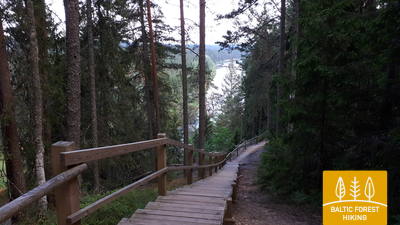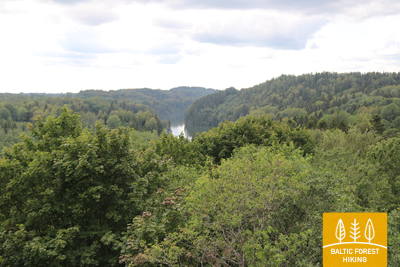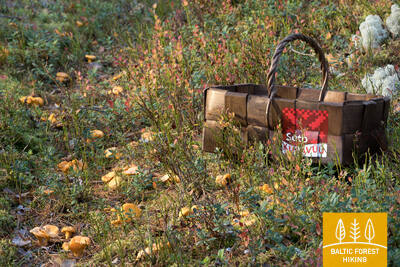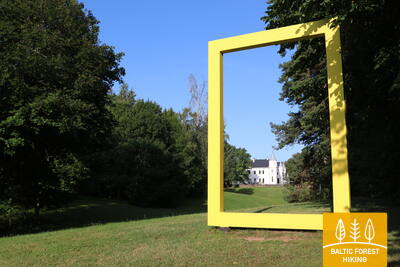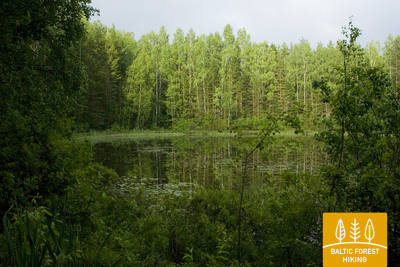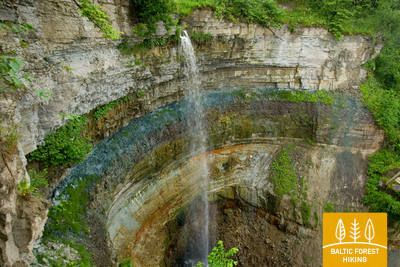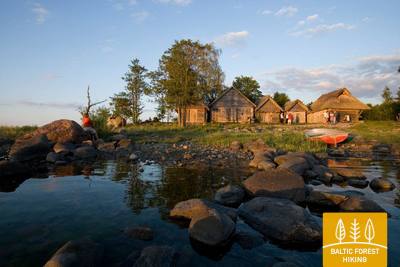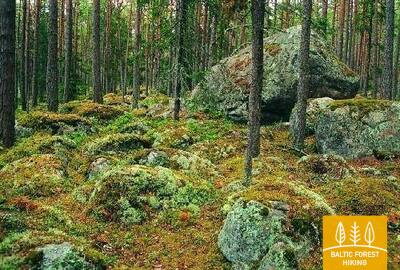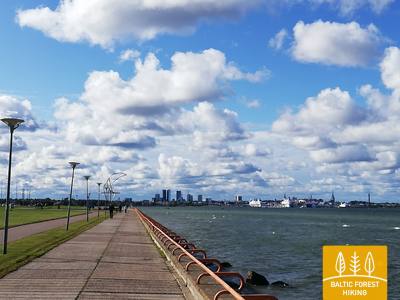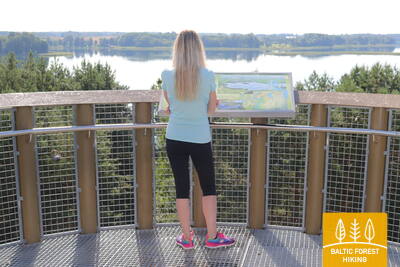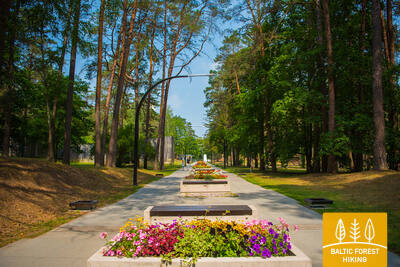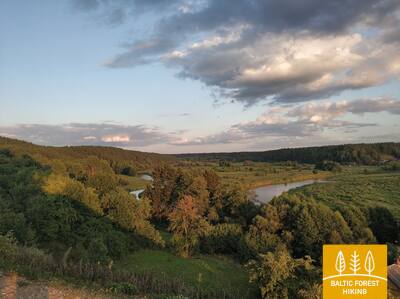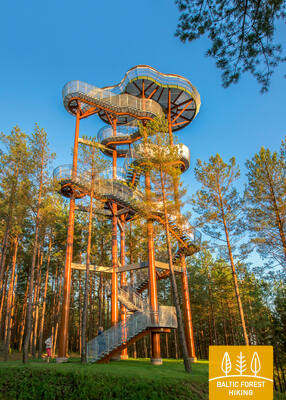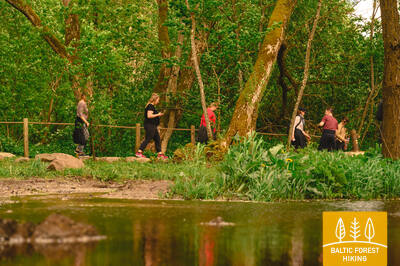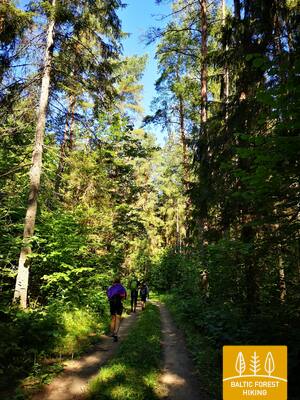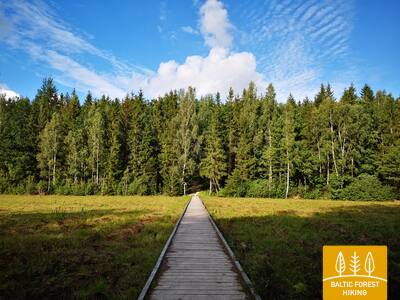Baltic Forest Hiking - Dream tour
 Section 4. Rāmkalni - Sigulda.
Section 4. Rāmkalni - Sigulda.
Stunning scenery of the ancient valley of Gauja River near Sigulda
Past “Rāmkalni”, the Forest Trail wanders up the steep banks of Gauja valley, passes through Gauja village and comes back down. Then it crosses river Lorupe and continues along the bends of river Gauja, passing one of the most spectacular outcrops of the river, the Velnala Cliffs, goes up to Ķeizarskats observation spot and circles down to Ķeizarkrēsls, adventure park “Mežakaķis” at Kaķīškalns and the Sigulda Bobsleigh and Luge Track.
 Section 5. Sigulda - Līgatne.
Section 5. Sigulda - Līgatne.
In the heart of Gauja National Park
After passing through Sigulda, the Forest Trail follows the River Vējupīte to Mound Paradīzes, where a steep staircase leads down into the ancient valley of Gauja River and the ravine of River Vējupīte. It continues to wind down smaller paths through meadows, crossing small rivers whose banks reveal sandstone outcrops. The last six kilometres of this section follow a smaller path down Līgatne Nature Trails. As it draws closer to Līgatne, the Forest Trail moves up the hills of Gauja valley, before descending back down into the deep ravine of Līgatne River, where the village of the former Līgatne Paper Mill is located.
 Section 6. Līgatne - Cēsis.
Section 6. Līgatne - Cēsis.
Along the old Cēsis road through the valley of Amata River
One of the most scenic parts of the Forest Trail stretches along the historic village of the Līgatne Paper Mill, passes Spriņģi Rock, curves along Skaļupe Trails and the Mythological Trail, stops at one of the most secret sites on this side of the Iron Curtain, the Soviet Bunker, then continues along Roči Nature Reserve, crosses Amata (the most beautiful and rockiest part of the river) and finally comes to Zvārtes Rock. Next, the Forest Trail runs along the high banks of Amata valley and follows the historic Cēsis–Riga “highway” (now a small rural/forest road with old mileposts) to Rakši, then ascends up the Vāļukalni hills and Ozolkalns, following along the River Gauja until it meets Cīrulīši Nature Trails. It comes to a stop at Gaujas street, but travellers may continue down the path for a further 2.8 km to Cēsis, spend the night there, and continue walking on the following day.
In this section, the Forest Trail winds through the impressive Gauja River Valley, also crossing the deep valleys of other rivers, such as the Amata. Along the banks of the Amata, the Forest Trail coincides with the Amata Geological Trail, leading to Zvārtes Rock—one of the most popular tourist attractions in Latvia, offering stunning views of the river valley. Near Cēsis, the Forest Trail coincides with the Cīrulīši Trail segment. The Forest Trail crosses the Gauja National Park along its entire length (from southwest to northeast).
 Section 7. Cēsis - Caunītes.
Section 7. Cēsis - Caunītes.
Impressive sandstone outcrops on the banks of River Gauja
The Forest Trail follows small roads and trails through the woods up until the water tourist camp “Lenči”, winds through the ever-changing terrain past Ērģeļu Cliffs and enters the ancient valley of Gauja River. Having passed Ērģeļu Cliffs, the trail turns back towards Cēsis, but then veers off towards Rāmnieki in Pieškalns, crossing the river. After the water tourist camp “Jāņarāmis” the Forest Trail enters a beautiful, bright pine forest, proceeding through the woods until it reaches “Caunītes”, which is one of the most beautiful places on the banks of the Gauja River.
In this section, the Forest Trail runs from the Ērģeļu Cliffs along the banks of the impressive Gauja River Valley through beautiful coniferous forests. From the Rāmnieki Bridge to Valmiera, it coincides with the "Cēsis - Valmiera" cycling route. The Forest Trail crosses the Gauja National Park along its entire length (from southwest to northeast).
 Section 8. Caunītes - Valmiera.
Section 8. Caunītes - Valmiera.
On the road to Valmiera – the “Green City”
From Caunītes, the Forest Trail leads through mesmerising pine forests and wetlands, across and around hills and slopes. One of the most beautiful views of the River Gauja opens from Sietiņiezis, and it might be worth devoting some extra time to visit the Sietiņiezis Nature Trail. The further road stretches along farmsteads and through forests, until reaching Valmiera. After Valmiera bypass, the Forest Trail leads down urban sidewalks, while the last stretch of road – from the so-called “Dzelzītis” (a narrow-gauge railway bridge) to Cēsu street – follows a wooded path along the Gauja River.
A section of the Forest Trail featuring beautiful and scenic pine forests covering the banks of the Gauja River Valley. From the Rāmnieki Bridge to Valmiera, the Forest Trail coincides with the "Cēsis - Valmiera" cycling route. The Forest Trail crosses the Gauja National Park along its entire length (from southwest to northeast).
 Section 15. Ape – Paganamaa – Korneti – Latvian/Estonian border.
Section 15. Ape – Paganamaa – Korneti – Latvian/Estonian border.
Through the Korneti-Peļļi Furrow and the Paganamaa or Devil's Land
After leaving Ape, the Forest Trail winds through a hilly farmland landscape, then enters a dark forest massive, occasionally interrupted by the blue surfaces of lakes. After Peļļi, the Forest Trail moves down the same path as Peļļi trail, crosses the Latvian/Estonian border and winds along the shores of Lakes Smilšājs, Sūneklis and Ilgājs for 2 km on the Estonian side, known as Paganamaa (translation: Devil's Land). There it descends and enters the Korneti-Peļļi subglacial depression, one of the most impressive ravines in Latvia. The Forest Trail returns to Latvia at Ilgājs and, after a steep climb, takes you through a hilly area to the Drusku castle mound. The Forest Trail descends in Korneti. It is less than 3 km from the centre of Korneti to the Latvian/Estonian border. Features beautiful landscapes on the banks of Lake Lielais Baltiņš and Lake Mazais Baltiņš along the route. The section is located in the protected landscape area “Veclaicene”.
One of the most beautiful sections of the Forest Trail in northern Latvia traverses part of the Alūksne Highlands and the glacier-formed Korneti-Peļļi Depression, revealing stunning hill and lake landscapes, which can be admired from observation towers. Ape is a scenic Latvian small town known for its characteristic low-rise buildings made of dolomite and its cobblestone streets.
 Section 19. Vana-Vastseliina‒Kolodavitsa.
Section 19. Vana-Vastseliina‒Kolodavitsa.
Along the banks of Piusa, the fastest river in Estonia
The first part of this section of the Forest Trail winds along the magnificent Piusa River valley, then, at Härmä village, it turns towards Obinitsa, an important cultural centre of Setomaa, the Land of Setos. Here you can discover the traditions of the local Seto people. After Obinitsa, the Forest Trail leads through beautiful pine forests rich in heather, descends back into the depths of the Piusa River valley and turns east at Piusa caves. From there it follows the left slope of Piusa valley until it reaches the motorway and railway line by Koidula railway station.
 Section 26. Varnja‒Alatskivi.
Section 26. Varnja‒Alatskivi.
Visiting the onion farmers of Lake Peipus
A scenic and tradition-rich stretch of the Forest Trail symbolised by the onion. Onions were brought to the region by Old Believers in the 17th century. Ladies and gentlemen selling home-made onion strings on the roadside have become somewhat of a business card of the villages. The villages on the twenty-four kilometre stretch of road between Varnja and Kallaste are connected by the tourist route called Onion Road. The landscape is decorated by colourful wooden houses, small fish shops and a restaurant where you can enjoy tea made in the samovar, true to the traditions of Old Believers. The fish vendace (rääbis) from Lake Peipus is served throughout the year.
 Section 31. Lohusuu‒Kuru.
Section 31. Lohusuu‒Kuru.
Through the mushroom and berry forests on the northern shore of Lake Peipus
The first half of this section leads through magnificent coniferous forests, especially in the Järvevälja landscape reserve, where the trail is surrounded by beautiful dunes in the north and a raised bog in the south. It is well worth visiting the kiosk at Rannapungerja to buy smoked fished – the Lake Peipus vendace (rääbis) and some local farm produce. The Forest Trail crosses the Rannapungerja River via the motorway bridge and comes to the shores of Lake Peipus at Kauksi. There is a picnic area to cosy up and eat the fish you’ve brought along. Here, the shores of Lake Peipus resemble a magnificent beach surrounded by beautiful pine-covered dunes.
Beautiful pine forests and swamps, and the unusually scenic shores of Lake Peipus, whose sandy beaches with high sand dunes resemble more of a sea coast than a lake shore. It is a suitable place for walks and hikes of various lengths depending on your abilities. The Peipus shore alternates with small settlements where various services are available.
 Section 34. Kuremäe‒Vasavere.
Section 34. Kuremäe‒Vasavere.
Through the Kurtna Protected Landscape Area
Having left the Kuremäe Convent hill, the Forest Trail continues along the picturesque Kurtna landscape reserve (part of Alutaguse national park), ornamented by the mirror surfaces of its many lakes (42 lakes in total, the highest density in Estonia) among beautiful, bright coniferous forests. Wooden footbridges pass through the wetter areas, while bridges are built over ditches and small rivers. A network of hiking and Nordic walking trails has been established in the vicinity of the Alutaguse recreation and sports centre.
 Section 36. Toila‒Saka.
Section 36. Toila‒Saka.
The scenic North-Estonian Klint between Toila and Saka
One of the most unusual sections of the Forest Trail in Northern Estonia, which leads along the foot of the impressive North- Estonian Klint in good weather, then climbs to the top of the klint in the villages of Valaste and Saka, revealing breath-taking views of the Gulf of Finland from the so-called Viru Rise. In the Saka‒Ontika‒Toila section (about 23 km), the maximum height of the North-Estonian Klint reaches 55 m. If the weather is clear, you can see the isles named Great and Small Tütarsaar, which belong to Russia, at a 50 km distance.
 Section 41. Eisma‒Oandu.
Section 41. Eisma‒Oandu.
Along the trails of Lahemaa National Park
Behind the village of Vainupea, the Forest Trail enters the first Estonian national park ‒ Lahemaa, which means “the land of bays” in Estonian. For the next five and a half days, the Forest Trail will continue along the bays and peninsulas of Lahemaa national park, introducing the hikers to its most significant natural and cultural heritage. Special attention must be paid to the rules of the park. On this day, the Forest Trail passes through beautiful and quiet coastal forests, where mushrooms grow abundantly in autumn. It passes through the scenic Altja fishing village. The section comes to an end at Oandu in the visitor centre of the Estonian State Forest Management (RMK), where hikers can learn more about forest habitat types and forest management traditions.
 Section 42. Oandu‒Käsmu.
Section 42. Oandu‒Käsmu.
Käsmu captains' village and ship building site
The next 9 kilometres of the Forest Trail between Oandu and Võsu coincide with the RMK trail, so be aware of the change of the signs. The trail goes through a beautiful, wooded inland dune area, where hikers can see cuts on pine trees, used to extract resin from the trees. Resin was obtained in the Baltic States using this method up to the 1960s-1970s. Trees are richly covered in lichen, indicating that the air is clean. In autumn, mushrooms and blueberries adorn the edges of the trail. After passing through Võsu village (a popular resort), the Forest Trail continues along a beautiful coastal forest promenade to Käsmu village. It is worth walking an additional extra kilometre to the Vana-Jüri rocks and the historical sites of Käsmu at the tip of the peninsula.
A scenically diverse section of Lahemaa National Park, where you can see forests formed on dune ridges and the Lahemaa coastline rich with bays and impressive boulders. The Käsmu fishing village is interesting with its low-rise wooden architecture, where each house's yard has a large stone. It is one of the most beautiful places on the Estonian coast
 Section 43. Käsmu‒Viinistu.
Section 43. Käsmu‒Viinistu.
In the kingdom of the giant rocks of the Käsmu Peninsula
The first part of this section passes through the fairytale-like Käsmu Peninsula with its wooded dunes and moss-covered rock fields. From Eru it continues along the Võsu‒Kotka road for 2 km, passes through Vihasoo village and further along the road, from where you can see Eru Bay and the Käsmu Peninsula. The section features some of the most impressive boulders in Lahemaa national park, the Tammispea and Jaani-Tooma boulders, which resemble huge monoliths. From Viinistu, you can spot the Mohni Island and its lighthouse in the distance.
An exceptionally scenic section of the Forest trail on the Käsmu Peninsula, where there are small paths leading through coastal forests covered with mossy stones. The small coastal villages with narrow streets and stones between buildings and yards are also interesting. In the village of Tammispea, you can see one of Estonia's most impressive boulders. It is part of the Lahemaa National Park area.
 Section 50. Püünsi‒Tallinn.
Section 50. Püünsi‒Tallinn.
Most beautiful sights of Old Tallinn
The Forest Trail passes by the Gulf of Tallinn, and beautiful views of the towers, harbour and skyscrapers of the city can be seen as early as in Püünsi. The Forest Trail turns into a beautiful pine forest before Pirita, then follows along a sandy beach for 2 km. Behind Pirita all the way to the Port of Tallinn, the Forest Trail takes you along the beautiful city waterfront promenade, which overlooks the city’s most important cultural and historical sites, and offers beautiful views of the sea and the port. The final destination of the Forest Trail is located in the Port of Tallinn, next to the Old Town. You can spend another day or two visiting various tourist locations of Tallinn.
 Section 52. Veisiejai – Trikojis.
Section 52. Veisiejai – Trikojis.
Through the Veisiejai Regional Park
After leaving the centre of Veisiejai town, the Forest Trail crosses the channel of Veisiejai lake, then, along Vytauto, Turgaus and Leipalingio streets (road No. 134), it takes you to the shore of Snaigynas lake, where there is an observation tower and recreation places. After crossing a small forest massif near Veisiejai, the Forest Trail leads for about 1.4 km on the Veisiejai – Barčiai (No. 2529) road, then turns right. It continues through a beautiful pine forest along Ančia lake, which is rich in berries and mushrooms. Turning to the east, the Forest Trail approaches Barčiai village from the south, and further to Trikojis lake leads through cereal fields. At the bay of Trikojis lake, the Forest Trail crosses wooded areas and goes to road No. 2517. This section of the Forest Trail is part of the Veisiejai Regional Park.
 Section 54. Didžiasalis – Druskininkai – Žiogeliai.
Section 54. Didžiasalis – Druskininkai – Žiogeliai.
Druskininkai – the most popular resort in Southern Lithuania
Between Didžiasalis village and the resort town of Druskininkai, the Forest Trail leads through a coniferous forest with abundant berry and mushroom spots. Before Druskininkai, the Forest Trail merges with the Nemunas road, turns around the Druskininkai Snow Arena and continues along the pedestrian and bicycle path to the Park Bridge across the Nemunas river. After crossing the bridge, the Forest Trail continues on Maironio street. and continues along the small streets of the historic Druskininkai resort and the park roads, crossing the Ratnyčia river and the forest park on the right bank of the Nemunas. The route behind Veisiejai street goes along the sidewalk of Neravų street and after about 1 km turns left into Sodžiaus street, which at the end of Neravai village becomes a beautiful forest road. This is where Dzūkija National Park begins. The Forest Trail turns around Viečiūnai village, opening a beautiful landscape to the Liškiava monastery on the opposite bank of the Nemunas. The Forest Trail then leads to Žiogeliai village along a beautiful secluded forest road.
A very diverse section of the Forest Trail, which includes both small paths and small country roads, as well as the popular Druskininkai resort with wide opportunities for active and passive recreation, enjoyment of history, traditions, and culinary heritage. The final part of the section is located in Dzūkija National Park.
 Section 55. Žiogeliai – Merkinė.
Section 55. Žiogeliai – Merkinė.
Through the Dzūkija National Park
Up to the Merkys estuary to the Nemunas, the Forest Trail leads along the banks of the Nemunas valley, where it is surrounded by large and beautiful forests of Dzūkija in the vicinity of the Dainava Lowland (Dainavos lyguma). In some places in the forest massif there are open places where small villages are scattered. Nearby Česukai village, the Forest Trail forms a large circle around the Merkys estuary to the Nemunas, because the nearest bridge is on the A4 road. Here you can see picturesque landscapes over the wide and deep Merkys valley. After crossing Merkys, the Forest Trail stretches along a narrow country road on the left bank of the river and leads to the Merkinė mound, from which one of the most beautiful landscapes of Southern Lithuania opens up. Along the small and winding streets of Merkinė (Piliakalnio, V. Sladkevičiaus, S. Dariaus and S. Girėno) the Forest Trail reaches the town centre. This section of the Forest Trail is a part of Dzūkija National Park.
 Section 56. Merkinė – Nemunaitis.
Section 56. Merkinė – Nemunaitis.
Along the Nemunas valley
In Merkinė small town, the Forest Trail goes along Seinų street in the direction of the Nemunas, turns right and comes to the observation tower. It offers an excellent landscape over the wide river valley and the island in the Nemunas river, which is grazed by livestock. For more than 3 km, the Forest Trail moves to the steep slopes of the Nemunas valley, then sharply turns to the north and further goes along small forest roads to the villages of Netiesos and Druskininkai. After Druskininkai village, it crosses the largest open area of this section with beautiful views. Then the Forest Trail runs along the Nemunas valley, but the river itself is not visible from the trail. In some places along the way there are hills with steep slopes. At Vangelonys village, the Forest Trail comes out again in an open place, crosses a small forest massif and reaches the main street of Nemunaitis village along Vangelonių and Saulėtekio streets. Part of this section from Merkinė to Druskininkai village is located in Dzūkija National Park.
 Section 69. Kirkšnovė – Kaulakiai.
Section 69. Kirkšnovė – Kaulakiai.
Through Dubysa Regional Park
About 0.5 km after Kirkšnovė the Forest Trail turns left from the Ariogala–Betygala road (No. 3504) and then up to the destination at the Raseiniai–Baisogala road (No. 225) winds along the bends of the Dubysa river, where floodplain meadows alternate with small forest massifs and little villages. In some places there are vast views of the high banks of the Dubysa valley and the castle mounds. There is a pronounced land relief in this section – the Forest Trail winds up and down the steep slopes of the shores, ensuring a memorable hiking experience. This is a section for hikers – “gourmets”!
 Section 73. Dengtiltis – Kurtuvėnai.
Section 73. Dengtiltis – Kurtuvėnai.
Through Kurtuvėnai Regional Park
Kurtuvėnai Regional Park is one of the most forested areas in Central Lithuania with very pronounced glacier-shaped terrain forms spread in the Eastern Žemaitija Upland, between the rivers Venta and Dubysa. From Dengtiltis, along small forest roads, the Forest Trail leads to Kelmė road (No. 2106), for a short time moves along to a northeast and after 0.4 km turns left. The trail further winds along forest paths in the direction of Pageluvis and Geluva lakes. After turning a loop around Geluvos, Barsukyno and Dubuko lakes, the Forest Trail continues in a westerly and north-westerly direction, crosses the A12 highway through a tunnel and further, along more open places, where small villages are located, makes another loop around Dambos pond. Kurtuvėnai village is located on the western side of the pond. Along the P. Višinskio street – main street of the village, the Forest Trail reaches the destination of this section.
 Section 74. Kurtuvėnai – Šaukėnai.
Section 74. Kurtuvėnai – Šaukėnai.
Natural wonders in Kurtuvėnai Regional Park
Along forest paths and small roads, the Forest Trail leads through Kurtuvėnai Regional Park. It is equipped with nature trails. From Kurtuvėnai, the Forest Trail leads along a beautiful tree alley and further along a small country trail winds between fish ponds, small hills overgrown with meadows, until it reaches the forest again. The trail turns around Vainagiai village, leads along a wooden footbridge through the wetland and reaches the castle mound on the shore of Vainagiai lake. For the next 8 km to Šaukėnai, it continues as a small forest road and, before entering the Šaukėnai small town, surrounds the northwestern shore of Juodlė lake. In Šaukėnai small town, the Forest Trail continues along Juodlės street.
 Section 83. Paplatelė – Plateliai.
Section 83. Paplatelė – Plateliai.
Around the largest lakes in the Žemaitija National Park
For the first 3.5 km, the Forest Trail leads through beautiful coniferous forests that cover the slopes of the Žemaitija Upland. Up to the Cold War exposition, it coincides with the Plokštinė cognitive trail. From the museum, the Forest Trail for 5 km follows the Plokštinė road, where a pedestrian / bicycle path has been created and, approaching Plateliai lake, descends into the lowland of the lake. At the road No. 3202 (Malūno street) , the Forest Trail turns left to the south-east and after 0.3 km turns right to right to the south-southwest. After about 0.5 km it reaches Ilgio Ežero street. For the next 5.5 km, the Forest Trail forms a wide circle around Ilgis and Beržoras lakes, reaching the Beržoras village. After the village, after 2 km along Plungės street, the Forest Trail reaches the centre of Plateliai and throws another circle along Ežero street to the beach and Šeirė educational trail. Then along Ežero, Naujoji and Žemaičių Kalvarijos streets, the Forest Trail returns to the centre of the town.
The section of the Forest Trail is entirely within the territory of Žemaitija National Park, forming a semicircle around Lake Plateliai. Exceptionally beautiful places with landscapes of the Žemaitija highlands' hills and lakes. There are extensive recreational opportunities - sunbathing, swimming, diving, boating, cycling, walking, mushroom picking, berry picking, nature watching, and enjoying national dishes. At the beginning of the section, you can see the former Soviet-era nuclear missile base and the Cold War exhibition.
 Section 95. Sabile – Kandava.
Section 95. Sabile – Kandava.
One of the most beautiful nature parks in Kurzeme
The Forest Trail continues along the left bank of the Abava, along Kr. Barona street. Further, as a small path, it crosses the meadows and forest clusters of the Abava valley until it reaches a hill called the Swedish hat (Zviedru cepure). After Zviedru cepure, the Forest Trail goes along a small country road to the Plosti – Pūces road (V1471), crosses Amula and at Kalnmuiža winds up in the Abava valley, along which the next 6 km leads to Aizdzire Manor park. Another 1 km to the north the Forest Trail crosses the Abava valley in its full width, revealing some of the most beautiful views of the valley. The depth of the Abava valley in this place is about 40 m. After the Fisherman's Bridge (Zvejnieku tilts), the Forest Trail rises on the northern slope of a valley where vineyards are planted. Winding through the forest, it crosses the Kandava–Renda road (P130) and further along Sabiles street reaches Kandava. Along the Lauku, Ozola, Zīļu, Sabiles and Pils streets of this picturesque small-town the Forest Trail reaches the Knights' Castle Mound. Throughout the section, the Forest Trail winds through the nature park “Abavas senleja” (“Abava valley”).
The ancient valley of the Abava River is one of the widest river valleys in Latvia and Kurzeme, with views of meadows and grasslands on the banks and slopes, small towns like Renda, Sabile, and Kandava, and many historical and contemporary cultural monuments, including hillforts, medieval castle ruins, manors and their parks, and the Pedvāle Art Park.
 Section 99. Jāņukrogs – Bigauņciems.
Section 99. Jāņukrogs – Bigauņciems.
Through Ķemeri National Park
After crossing the area with some homesteads, the Forest trail winds through beautiful coniferous forests and further 6.5 km along Čaukciems until the turn to the Green Dune leads along the side of the Antiņciems–Smārde road The neighbourhood is flat, as the section is part of the Engure plain of the Piejūras Lowland. The Green Dune (Zaļā kāpa) offers wide views of the Green Bog (Zaļais purvs) and the Witches' Bog (Raganu purvs). A small forest road bends along the lower part of the dune and in two places crosses the bog along wooden footbridges. In Ķemeri, the Forest Trail moves along Partizāna, Robeža, A. Upīša, Katedrāles and E. Dārziņa streets, along the Forest House and Vēršupīte, into which the waters of sulphur springs flow. Crossing Tūristu street, it continues along the Dūņu road to the Sloka lake. Further the trail crosses the Vēršupīte swamp forest, which is one of the most outstanding wet forest habitats in the whole part of the trail in Kurzeme. At Melnezers it turns onto the Old Ķemeri road and after 2 km it reaches Bigauņciems. Behind the Talsi highway, the Forest Trail reaches the shore of the Gulf of Riga and connects with the Coastal Hiking Trail. The Forest Trail runs through the Ķemeri National Park along the entire section.
In this section, the Forest Trail crosses Ķemeri National Park, which was established primarily for the protection of wetlands and related habitats and biodiversity. The park features several nature trails, some of which coincide with the Forest Trail. The route includes the park's visitor center. This section can be divided and hiked in two days.









